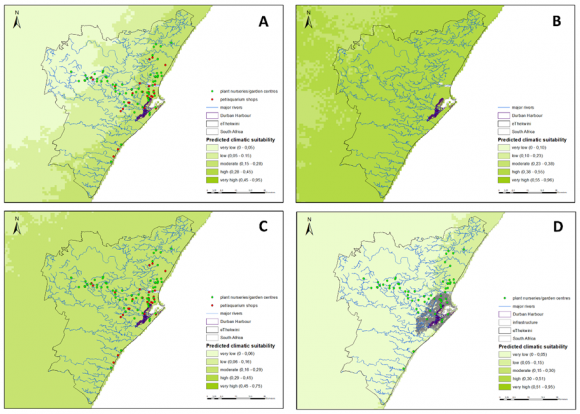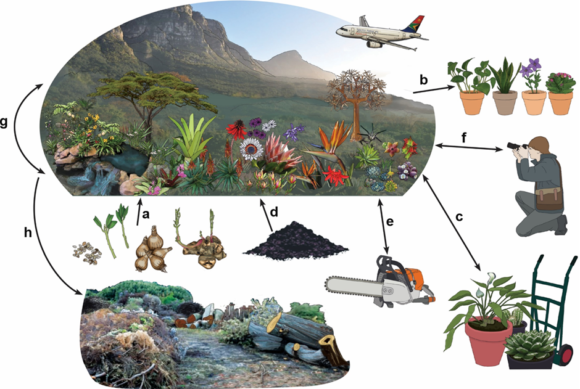10 August 2021 | By Emily McCulloch-Jones
The high demand for ornamental plants at a global scale, combined with modern and increasingly efficient modes of trade (i.e., e-commerce), highlights the horticultural trade industry as a subject of major conservation concern. Historically, ferns are well documented as being a popular ornamental plant group and recent studies have highlighted their high propensity towards invasion. Despite this, no studies have considered the role of trade as a driver of invasiveness in this large plant group.
This topic was tackled in a recent publication in the journal Biological Invasions, led by C∙I∙B-funded PhD student Emily McCulloch-Jones from Nelson Mandela University (NMU). Additional researchers affiliated with NMU, Dr Tineke Kraaij and Prof. Herve Fritz, as well as South African fern expert Prof. Neil Crouch were co-authors.
The paper considers six major trading countries across the globe and showed that successful establishment in traded alien ferns is influenced by both species and market traits, specifically trade through e-commerce and the number of varieties and cultivars available for a species (a proxy for the effects of horticultural manipulation and ecotypic variation) (Figure 1).

By consulting horticultural catalogues to identify introduced species, i.e., adopting a horizon-scanning approach, the study identified 382 traded ferns, 261 of which were traded as aliens. The study further identified 29 species of traded alien fern that have successfully established elsewhere but currently have the status of introduced in their country of trade.
The researchers suggest that these species should be closely monitored and recognised as potential invaders present in trade. Some invasive species negatively affect their invaded environment, for example, large colonies of Holly fern (Cyrtomium falcatum), which is native to Asia, compete for habitat along the rocky coasts of Western Europe and South Africa. Holly fern also readily colonises man-made structures in coastal towns and cities (Figure 2).

The authors also highlight the importance of apogamy, which permits the production of young plants without fertilization and allows for more rapid maturation of sporophytes and thus the earlier production of spores. Apogamous species such as Holly fern and Tassel fern (Polystichum polyblepharum) were identified as highly traded in the study. The researchers suggest that consideration of apogamy in other traded alien ferns will be useful in future studies that assess invasive potential.
“There are still so many questions surrounding alien ferns, but it is evident, at least, that their spread is most dominantly promoted through horticultural trade. It is great to have an inventory of species and some indication of their propagule pressure in different parts of the world. This is useful information as it has a tangible output and provides direction towards the management of current and future fern invasions” – Emily McCulloch-Jones
It is likely that there are significantly more alien ferns across the globe than currently documented, given that the desktop approach applied in this study identified an additional 104 introduced species of alien fern across six countries when compared with a recent study (Jones et al. 2019) which identified relatively few introduced species at a global scale.
“It is so important to identify species introductions from their source. It is most likely that we identified more introduced species in this analysis compared to the previous study due to our survey approach, which considered nursery catalogues rather than formal inventories on alien and native flora. Furthermore, it is likely that there are still more alien fern species in the market than what we could detect.” – Emily McCulloch-Jones
The authors suggest that their methodology of screening horticultural catalogues for traded alien fern species allows for the early detection of introduced species and is an approach, which should be implemented globally as a means to inform policy and legislation surrounding potential invaders introduced through trade. The full trade data set is still being assessed, following which the authors hope to provide country-specific management recommendations.
Read the full article
McCulloch-Jones, E., Kraaij, T., Crouch, N. and Fritz, H. 2021. The effect of horticultural trade on establishment success in alien terrestrial true ferns (Polypodiophyta). Biological Invasions. https://doi.org/10.1007/s10530-021-02599-0
Jones, E.J., Kraaij, T., Fritz, H. and Moodley, D. 2019. A global assessment of terrestrial alien ferns (Polypodiophyta): species’ traits as drivers of naturalisation and invasion. Biological Invasions. https://doi.org/10.1007/s10530-018-1866
For more information, contact Emily McCulloch-Jones at s216016479@mandela.ac.za



